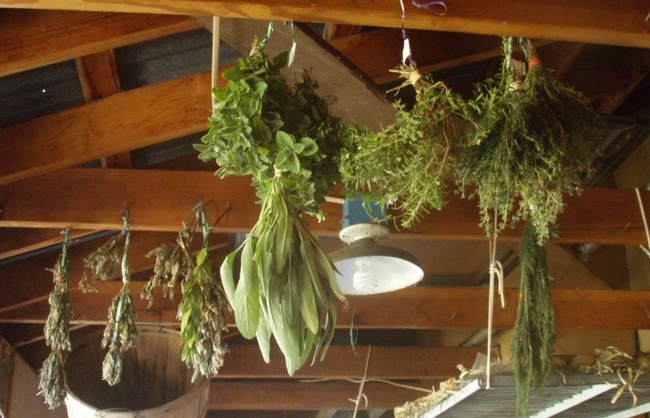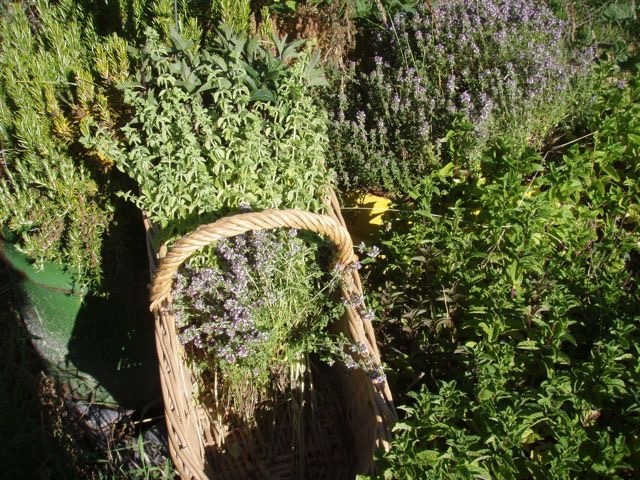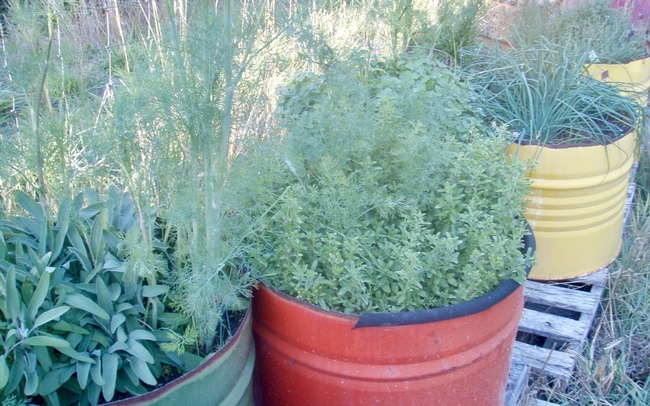
Freeze fresh herbs by placing a few sprigs or leaves in freezer wrap, then a freezer bag, and freeze. Or you can chop the herbs and place in ice cube trays and cover with olive oil. Once frozen, pop out and place in freezer bag. Herbs freeze well as one of the many versions of pesto (a herb, garlic, nut paste) to freeze, too. Traditional basil or parsley, cilantro, or mint can all be a base for pesto. Pack into small canning jars or freezer bags and freeze. I like to use clean, re-purposed 8oz deli or dairy product containers. Look online for recipes.
Preserve herbs by drying.
Hardy Herbs — Sturdy herbs such as rosemary, sage, thyme and parsley are easy. Tie into small bundles and hang to air dry. Do NOT dry in the sun as the herbs will lose flavor and color.
Tender Herbs — Basil, oregano, mints and others have high moisture content and must dry quickly. Hang tender-leaf herbs inside paper bags to dry. Cut holes in the sides of bag. Suspend a loose bunch (packed tightly they can mold) of herbs in a bag and close the top with a rubber band. Hang where there is good air circulation. Mature Dill seed heads or coriander (cilantro seed) benefit from this method as any seeds that fall off will be caught in the bag.
Dehydrator: Pre-heat dehydrator to 95°F to 115°F. In areas with higher humidity, temperatures up to 125°F may be needed. Place herbs in a single layer on dehydrator trays and dry 1 to 4 hours. Check periodically. Herbs are dry when they crumble, and stems break when bent.
When leaves are crispy dry they're ready to store. Remove from stems if needed, and leave whole to crush when used for best flavor. Store in cool, dry, dark area in airtight containers to protect color and fragrance. Label with the date so you can use the oldest first.
Dried herbs are 3 to 4 times stronger than fresh! Only use 1/4 to 1/3 of the amount listed in a recipe to substitute for fresh.
Vinegars and Herbal seasonings:
Fresh herbs can also be used to make flavored vinegars, herb blends, or herb ‘Infused Salts'.
Herbal Vinegar
A simple mixed - herb vinegar can be made by taking 3 sprigs each of clean, dry, fresh parsley, rosemary, and thyme, crushing lightly placing into a clean, sterilized, pint jar. Heat 2 cups distilled white or wine (red or white) vinegar to just below boiling (at least 190º) and pour over herbs, leaving ¼” headspace. Wipe rims of jars and seal with clean lid. Let sit undisturbed in cool, dark place to absorb the flavor, then strain and re-bottle. Use in salad dressings and marinades as desired.
Herb Infused Salts
- 4 to 5 garlic cloves, peeled
- 3/4 to 1 cup kosher or sea salt
- About 2 cups total, loosely-packed mixed fresh herbs (such as sage, rosemary, thyme or small amounts of lavender, peppercorns, citrus zest, chive flowers). Traditional Tuscan herb salt uses rosemary and sage.
- Mound salt and garlic on a cutting board. Use chef's knife to mince garlic, blending with salt as you work. Place herbs in a mound and coarsely chop. Blend in garlic salt and chop until the mixture is the texture of coarse sand.
Or, use a food processor instead, by combining the garlic and ONLY 2 tablespoons of the salt. Pulse until garlic is chopped medium-coarse. Add herbs and continue pulsing until the mixture is the texture of very coarse sand. Transfer to a sheet pan and toss with the remaining salt.
- Spread salt on baking sheet and leave for a few days to dry. Or dry in preheated oven (low) with heat turned off for a few hours. Store in clean, dry jars.
ADDITIONAL RESOURCE LINKS
Flavored Vinegars - University of Georgia Cooperative Extension
Information on Home Food PreservationI - National Center for Home Food Preservation
UCCE Humboldt/Del Norte Master Food Preservers Website
Questions about the UCCE Master Food Preserver Program? Questions about food preservation? Interest in a demo? Contact the Humboldt/Del Norte Counties Cooperative Extension Office at: 707-445-7351